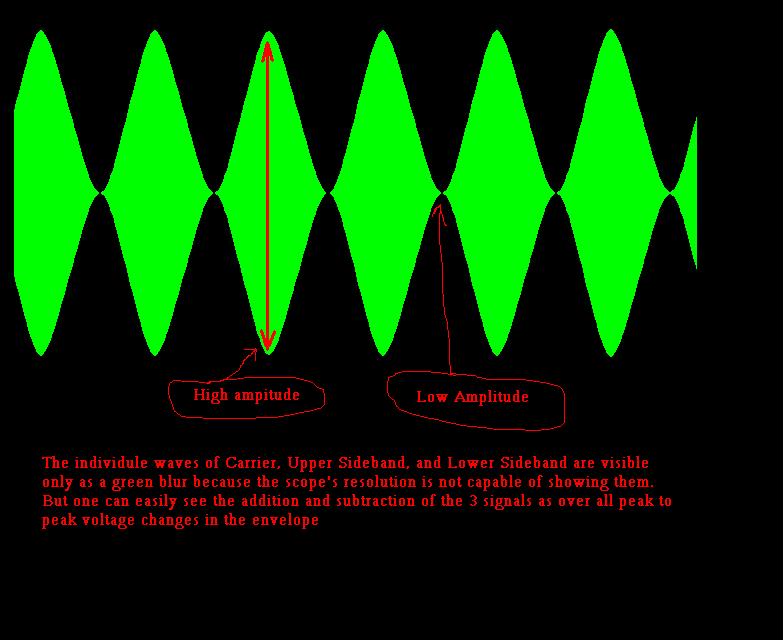Amplitude Modulation:
Amplitude Modulation is the method of superimposing intelligence on
a carrier wave by means of varying the amplitude with the
wave shape of the intelligence. When one looks at an AM signal on a scope
with a linear horizontal sweep and a wide band pass it appears as one signal
varying in amplitude. This is known as viewing the envelope. But when the
band pass is narrowed keeping the carrier frequency as the center, we begin
to see that the higher frequency modulation disappears, and as we narrow
the band pass further, more and more of the modulation disappears, until
all that is left is a carrier of unvarying amplitude.
This is because the products of modulation are actually upper and lower
sidebands. The only thing that they have in common with the carrier is
it's exact center reference point in the band spectrum and with the carrier
as reference the two sidebands are mirror images of each other in both
frequency and phase. This is a very important characteristic as we will
explain later.
 The
reason the signal on the scope appears to vary in amplitude is because
the scope shows the sums of all the signals it receives. At the peaks on
the scope, the phase of all of the signals are the same so they add together
to make one large pattern. At the trough of the scope's picture, the sideband's phases are such as to subtract from the carrier resulting in a small amplitude at that point of the pattern.
The
reason the signal on the scope appears to vary in amplitude is because
the scope shows the sums of all the signals it receives. At the peaks on
the scope, the phase of all of the signals are the same so they add together
to make one large pattern. At the trough of the scope's picture, the sideband's phases are such as to subtract from the carrier resulting in a small amplitude at that point of the pattern.
Click on Image to show full size.
It is important that the sidebands each act on the carrier in the same
way at the same time. That is to say that if the upper sideband is headed
towards being in phase with the carrier then the lowerside band must also
be acting in the same manor or a true reproduction will not be possible.
This is not to say that it will not be intelligible. It will just not be
a true reproduction of the modulating intelligence. This is why the carrier
must be in the exact center of the two side band's spectrum with respect
to both frequency and phase.

As a matter of fact, if the carrier is shifted 90 degrees with out moving
the side bands then envelope detection would yield virtually no intelligence
at all. The intelligibility would increase however if the carriers phase
was to continue to change passing the 90 degree point and would be best
again at 180 degrees. This occurs because the side bands work best and
together against the carrier if it is dead centered between them with respect
to frequency and phase. At the 90 degree point the side bands will not
work together against the carrier at all. At the 180 degree point, the
intelligence would be good but the detected intelligence would also be
180 degrees from where it would otherwise be.
This is all true as long as both side bands are present. If one side
band is not transmitted then the phase of the carrier no longer matters
but the frequency of course and amplitude do. See SSB
for more details.
Generally speaking, if the carrier that you used to create the modulation
is transmitted with the side bands and then used as the reference carrier
for the purpose of detection all the phases will be good and the intelligence
will be best. There are however a few things that
can cause distortion of the transmitted signal both in the equipment and
in the propagation path that need to be considered.
Other Tech Stuff:
Some theory about Audio Driving
a Class B Modulator , with diagrams
Xtal Mic Equilizer with diagram,
More theory about Matching
Impedances and Power Transfer
Basics of SWR and Transmission Lines
Basics of Push Pull Triode Class "C" Plate Modulated Finals
 The
reason the signal on the scope appears to vary in amplitude is because
the scope shows the sums of all the signals it receives. At the peaks on
the scope, the phase of all of the signals are the same so they add together
to make one large pattern. At the trough of the scope's picture, the sideband's phases are such as to subtract from the carrier resulting in a small amplitude at that point of the pattern.
The
reason the signal on the scope appears to vary in amplitude is because
the scope shows the sums of all the signals it receives. At the peaks on
the scope, the phase of all of the signals are the same so they add together
to make one large pattern. At the trough of the scope's picture, the sideband's phases are such as to subtract from the carrier resulting in a small amplitude at that point of the pattern. 